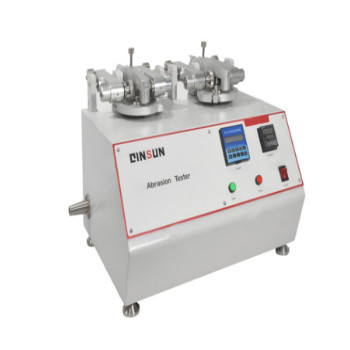Taber Abrasion Tester Original Grinding Wheel Type
The basic component of the Taber Abrasion Tester is the type of grinding wheel used. Taber offers standard grades of original Taber grinding wheels designed to meet a variety of specific applications. The grinding wheels are developed by Taber Industries. During use, the bonding material breaks down and is exposed, creating a new wear surface.The small available diameter of the TAB grinding wheel is 44.4 mm, which corresponds to the wheel label.
TAB abrasive wheels are available in the following types:
Calibrated-elastic grinding wheels are composed of an elastic bond and alumina or silicon carbide abrasive grains and are commonly used to evaluate rigid specimens.

Calibration-non-elastic grinding wheels, consisting of a ceramic (clay) binder and silicon carbide or alumina abrasive grains. Typically used to evaluate flexible specimens.
Specialty-Used for special applications:
For calibration and correction grinding wheels, different grades are available to meet different wear requirements. Original Tabor grinding wheels are selected for their composition and reset for normal wear. The quality and consistency of the grinding wheels is ensured by continuous inspection and sampling and strict control of the production process.
Wheels are sold in pairs and are packaged in sealed boxes to prevent damage. Each wheel is labeled "left (right) - this side out" to ensure that the installation position remains the same when the wheel is removed or reinstalled. For calibration and alignment wheels, the label is also used to indicate the small diameter of the wheel (1.75" OD or 44.45 mm). When the grinding wheel wears down to the label position, it must be replaced.
Depending on the type of abrasive and specimen, the grinding wheel surface must be cleaned frequently, as material from the specimen may transfer to the wheel surface and cause changes (e.g., clogging). As the abrasion resistance of the grinding wheel can be affected by oil and other contaminants, only the sides of the wheel should be touched during work.
The service life of a set of original Tabor grinding wheels depends on the load, the friction characteristics of the surface material and the material under test, and the frequency of regrinding the surface.
Most published test methods specify which grinding wheels are to be used. If a specific standard is referenced, check its grinding wheel counterpart. If there is no off-the-shelf procedure for your application, it is good to decide which grinding wheel to use after testing the actual material. The ideal selection criteria is to simulate the wear of the material in actual use. It is important to remember that wear is a complex phenomenon that may not be fully reproduced by accelerated wear tests, and that grinding wheels can only simulate a limited portion of the wear that the material surface will encounter in actual use.
The CS-8 calibrates the SE-an resilient wheel, which provides a gentler grinding action and is designed to work under loads of 250 or 500 grams. The surface can be reground with the S-11 smooth disc.
CS-10F A resilient wheel that provides a milder grinding action and is designed to work under a load of 250 or 500 g. CS-10F is typically used to test materials such as safety glass, clear plastics, etc. The surface is to be reground with an ST-11 smooth stone.
CS-10 Calibrated SE-This flexible grinding wheel provides a mild-moderate abrasive action. Just like normal handling, cleaning, polishing. This wheel has been used extensively to evaluate a variety of materials including organic coatings, plastics, textiles, leather and paper products. Surfaces can be reground with the S-11 Smooth Disc.
CS-10P - The polishing rate is the same as the CS-10, but the design of this wheel allows the wheel surface to be unloaded when testing paper products. It is suitable for short periods of time (e.g. 100 cycles) where the surface needs to be resharpened every tenth test.
CS-10W SE-This wheel is the same as the CS-10, but is white in color to prevent transfer of the wheel's color to the sample.
CS-17 Compared to the CS-10 grinding wheel, the CS-17 causes severe wear. Normal operation uses a load of 500 or 1000 grams. This wheel is used for testing materials such as aluminum anodizing, powder coatings, ceramics, plastics and enamels. Surfaces can be reground with the S-11 smooth disc.
WARNING:Due to possible deterioration, grinding wheels should not be used after the marked shelf life has expired.
2022-12-07 13:14
- Related News
The importance of battery internal resistance testing in the battery manufacturi
Application and structural principle of high and low temperature test chamber
Application of Small Coating Machine in Polyimide Slurry
Principles and selection methods of laboratory incubators
Evaluation of Moisture Absorption and Rapid Drying Performance of Textiles by Na
Liquid Moisture Management Tester
Paper ring compression strength tester standards
